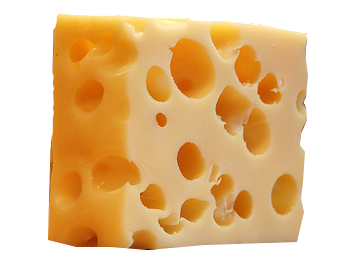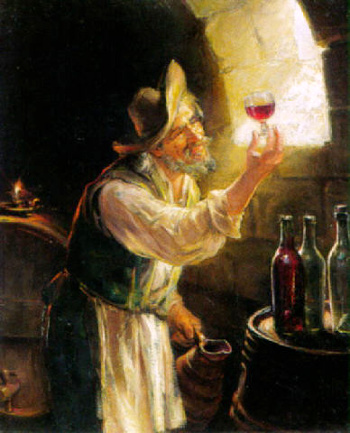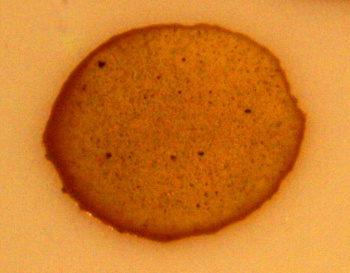Whiskey
January 20, 2020
Early in our
marriage, I accompanied my
wife on her
job interview at a
university research department. While I waited for her, I spent my time browsing in the department's
library. There I found an interesting
newsletter that listed
actions by the
US Food and Drug Administration. One item caught my attention. Someone had
drilled holes in
cheese in order to sell it as properly
aged Swiss cheese. The cheese was seized and destroyed for
adulteration.

A block of Swiss cheese.
Swiss cheese with larger "eyes" has a deeper flavor, since it has undergone a longer fermentation.
Annual Swiss cheese production in the United States is somewhat more than 300 million pounds.
(Wikimedia Commons image.)
Swiss cheese is a
generic term for cheese that resembles the actual Swiss cheese,
Emmental. While anyone can sell an Emmental cheese,
real Emmentaler Switzerland cheese is a
protected designation; that is, the name can only be used for cheese made in a
specific geographical area, very much like
real Champagne is only produced in the
Champagne region of France, about 100 miles east of
Paris.
Specific designations exist for
wines and cheeses, but also for
cognac,
sausages,
olive oils, and
balsamic vinegar, among many other
foods. Some cheese examples include
Gorgonzola,
camembert,
roquefort, and
Grana Padano. I wrote about
protected designation of origin (PDO), including the Italian
Denominazione di Origine Protetta, in a
previous article (Neolithic Cheese, October 15, 2018)
Counterfeits, such as the adulterated Swiss cheese that I mentioned above, harm the
reputation of the actual product. As a consequence,
government agencies use
scientific forensic techniques to identify such counterfeit products. Since fine wines are an expensive product,
chemists have been developing techniques for the forensic
analysis of wine. One study by a team of chemists from
Poland and
Spain identified 27
parameters describing
chemical compositions for verification of a wine's
authenticity.[1] They used a
likelihood ratio analysis to verify the authenticity of 178 samples of the three
Italian wine
brands,
Barolo,
Barbera, and
Grignolino, with
90% certainty.[1]

Une bonne goutte! (A good drop!), an oil on canvas painting by Joseph-Noël Sylvestre (1847–1926).
Human senses gave a very good account of wine type and quality before analytical chemistry entered the scene.
There's been research on an electronic tongue. I wrote about such a device for analysis of beer in an earlier article (Beer Tongue, February 10, 2014)
(Wikimedia Commons image.)
Physicists have also applied their skill to wine forensics.
Cesium 137 (
137Cs) is a
radioactive isotope with a
half-life of 30.17
years. This short half-life means that this isotope was not present in the
environment until it was created by
nuclear weapon testing beginning with the
Trinity nuclear test on July 16, 1945.[2] Wine created after this date will emit small amounts of
gamma radiation by
nuclear fission, and this radiation can be seen with a
sensitive detector. As a consequence, new wine sold in
vintage bottles of expensive varieties can be detected.
Additional cesium 137 was created during the
1986 accident at the Chernobyl reactor and the
2011 Fukushima Daiichi disaster. Apparently, no cesium 137 was released during the
Three Mile Island accident in 1979. Wine lovers need not worry that much about radiation in their wine. It's so small that detection must be done in laboratories deep
underground, and the
lead shielding for the detector must be made from lead that was
smelted prior to nuclear testing.[2]
Physicists have also found a different method of sorting another
alcoholic beverage.
American whiskey can be distinguished from
Scotch whiskey (usually spelled, whisky, without the
e) by
image analysis of the
residue left when
drops of these
evaporate.[3-7] This isn't the first time that residues from
evaporated liquids have been studied. As I reported in three previous articles,
Coffee Ring Physics, February 11, 2013,
Coffee Rings, December 10, 2010 and
Coffee Rings (Part II), August 25, 2011,
coffee ring formation has been studied. Coffee rings form from the deposition of
solid particles from the coffee
colloid. The ring shape is a consequence of the outward flow of these suspended particles.

A coffee ring.
Physical laws, such as gravitation and surface tension, and conservation laws, such as minimization of surface energy, create natural objects with very similar forms.
A biologist will see a similarity between this image and that of a cell, and an astronomer might mistake this as an asteroid.
(Wikimedia Commons image by Okin.)
Authors from the
University of Louisville (Louisville, Kentucky) presented their research on whiskey analysis in a recent
paper at
Physical Review Fluids, and as a
poster paper entitled, "Whiskey Webs: Microscale "fingerprints" of bourbon whiskey," at the
71th Annual Meeting of the APS Division of Fluid Dynamics (November 18, 2018 - November 20, 2018).[3-5] Science progresses by extending previous research. In this case, the Kentucky research team was inspired by a 2016 paper in
Physical Review Letters.[6-7] They discovered that droplets of whiskey aged in new,
charred barrels, that is American whiskey, produced a
pattern reminiscent of the
blood-vessel network of a
human eye after evaporation.[4] Not only that, but such patterns acted like unique
fingerprints of the whiskey type and age.[4]
Scotch whiskey derives its flavor from its aging in old,
recycled barrels.[4] American whiskey, such as
bourbon, is aged in new, charred,
oak barrels.[4] The different aging processes leads to differences in chemical composition, and this appears to manifest itself in the residue patterns seen from evaporated drops, with the American whiskey leaving
web-like patterns that are absent for other liquors.[4]

Web-like patterns in evaporated droplets of American whiskey. These patterns are for (a) Four Roses™ at 22.5% Alcohol by volume (ABN), (c) Maker's Mark™ Cask Strength™ at 22.5% ABV, and (e) Pappy Van Winkle's Family Reserve™ 23 Year™ at 25% ABV. (Portions of fig. 3 of ref.3, published under the Creative Commons Attribution 4.0 International license.)
The research team speculates that these web patterns arise from chemical compounds extracted from the charred barrel wood by the aging whiskey.[4] These
molecules agglomerate, then collapse into the
two-dimensional residue pattern after evaporation. They intend to test this
hypothesis by placing
tracer molecules inside the drops to
visualize movement during the evaporation process.[4]
References:
- Agnieszka Martyna, Grzegorz Zadora, Ivana Stanimirova, and Daniel Ramos, "Wine authenticity verification as a forensic problem: An application of likelihood ratio test to label verification," Food Chemistry, vol. 150 (May 1, 2014), pp. 287-295, https://doi.org/10.1016/j.foodchem.2013.10.111.
- How Atomic Particles Helped Solve A Wine Fraud Mystery, NPR Morning Edition, The Kitchen Sisters, June 3, 2014.
- Stuart J. Williams, Martin J. Brown VI, and Adam D. Carrithers, "Whiskey webs: Microscale "fingerprints" of bourbon whiskey," Phys. Rev. Fluids, vol. 4, no. 10 (October 24, 2019), Article no. 100511, DOI:https://doi.org/10.1103/PhysRevFluids.4.100511.
- Matteo Rini, "Synopsis: Telling Whiskey from Whisky," Physics, October 24, 2019.
- Stuart J. Williams, Martin J. Brown, VI, and Adam D. Carrithers, "Whiskey webs: Microscale "fingerprints" of bourbon whiskey," 71th Annual Meeting of the APS Division of Fluid Dynamics (November 18, 2018 — November 20, 2018), Poster P0002, DOI: https://doi.org/10.1103/APS.DFD.2018.GFM.P0002. The poster appears at the Gallery of Fluid Motion.
- Hyoungsoo Kim, François Boulogne, Eujin Um, Ian Jacobi, Ernie Button, and Howard A. Stone, "Controlled Uniform Coating from the Interplay of Marangoni Flows and Surface-Adsorbed Macromolecules," Phys. Rev. Lett., vol. 116, no. 12 (March 25, 2016), Article no. 124501, DOI:https://doi.org/10.1103/PhysRevLett.116.124501.
- Michael Schirber, "Synopsis: Whisky-Inspired Coatings," Physics, March 24, 2016.
Linked Keywords: Marriage; wife; job interview; university; research; academic department; library; newsletter; Regulation of food and dietary supplements by the U.S. Food and Drug Administration; action; US Food and Drug Administration; drill; hole; cheese; cheese ripening; age; Swiss cheese; adulterated food; adulteration; flavor<; fermentation; United States; pound (mass); Wikimedia Commons; generic term; Emmental cheese; protected designation; geographical indication; specific geographical area; appellation; real; Champagne; Champagne (wine region); Paris; wine; cognac; sausage; olive oil; balsamic vinegar; food; Gorgonzola; Camembert; Roquefort; Grana Padano; Geographical indications and traditional specialities in the European Union - Protected designation of origin (PDO); counterfeit; reputation; government agency; forensic science; scientific forensic; chemist; wine chemistry; analysis of wine; Poland; Spain; parameter; chemical composition; authentication; authenticity; likelihood-ratio test; likelihood ratio analysis; Italy; Italian; brand; Barolo; Barbera bianca; Grignolino; confidence interval; 90% certainty; oil on canvas painting; Joseph-Noël Sylvestre (1847–1926); human; sense; wine type and quality; analytical chemistry; research; electronic tongue; beer; Sylvestre Ein guter Tropfen; physicist; Cesium 137; radionuclide; radioactive isotope; half-life; year; biophysical environment; nuclear weapon; Trinity nuclear test; gamma ray; gamma radiation; nuclear fission; gamma spectroscopy; sensitive detector; vintage (design); bottle; 1986 accident at the Chernobyl reactor; 2011 Fukushima Daiichi disaster; Three Mile Island accident; subterranea (geography); underground; lead; radiation protection; radiation shielding; smelting; smelted; alcoholic beverage; American whiskey; Scotch whiskey; image analysis; residue (chemistry); drop (liquid); evaporation; evaporate; coffee ring effect; solid; particle; colloid; physical law; gravitation; surface tension; conservation law; surface energy; nature; natural; biologist; cell (biology); astronomer; asteroid; Benutzer:Okin; University of Louisville (Louisville, Kentucky); academic publishing; paper; Physical Review Fluids; poster session; poster paper; 71th Annual Meeting of the APS Division of Fluid Dynamics (November 18, 2018 - November 20, 2018; Physical Review Letters; char; charred; barrel; pattern; blood-vessel; network; human eye; fingerprint; recycling; recycled; bourbon whiskey; oak; spider web; web-like<; pattern; Four Roses; Alcohol by volume (ABN); Maker's Mark; Pappy Van Winkle's Family Reserve; Creative Commons Attribution 4.0 International license; molecule; flocculation; agglomerate; two-dimensional; hypothesis; flow tracer; scientific visualization.